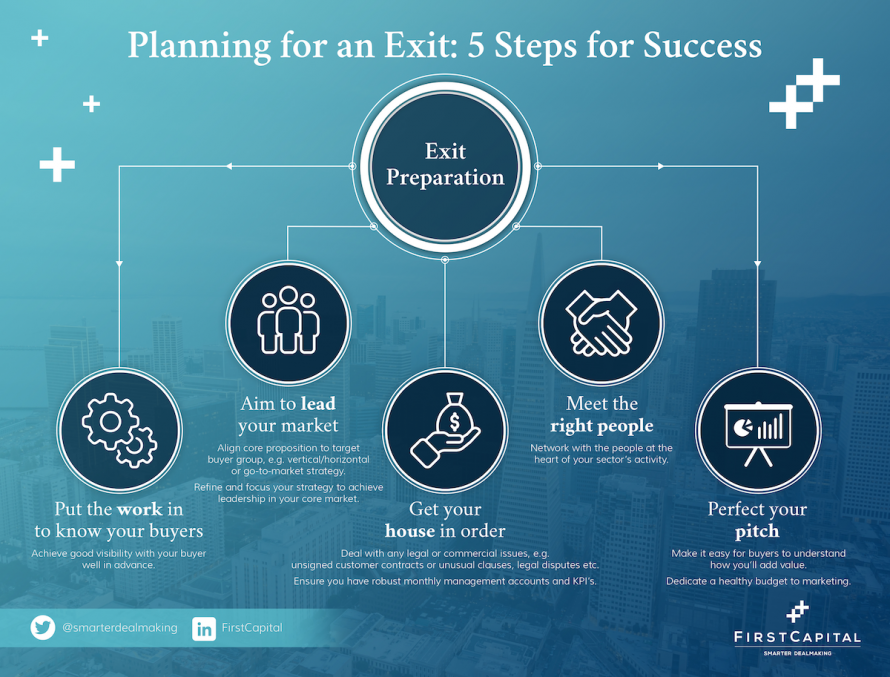Demystifying M&A
Planning for an Exit: 5 Steps for Success
2nd March 2018
By Hazel Moore
The sale of your business is usually the culmination of a journey rather than an event. Although on rare, lucky, occasions the right buyer turns up and makes an offer you can’t refuse, for most people it’s a long-term process that requires hard work, planning and preparation. From our experience, we know that to give yourself the best chance of maximising the outcome, it’s never too early to start preparing.
Here are the five steps we recommend you take, starting at least a year (or maybe two) before you actually expect to sell:
1. Put the work in to know your buyers: Research which type of buyer is strategically best for your business, draw up your target list, and then set about getting to know them. In the vast majority of acquisitions, the business is already known to the buyer pre-sale, and may well even be on a “list” of potential targets. You should aim to achieve good visibility with your buyer group well in advance (be at the same conferences, develop shared customers for example), and build a deep understanding of where you add value, in which division, with which products and with the key individuals that you need to know. Importantly, also check “fit” – do the organisation’s business goals align with what you’re looking to achieve for your business?
2. Aim to lead your market: This speaks to value. Market leaders, even in a niche, are price setters and thought leaders. They are more highly sought after and can generally demand a higher price. It’s worth spending time on your strategy, and refining that according to your target buyer group. Most growth stage companies are resource-limited, so you need to make some decisions. Do you demonstrate leadership by going deep into a vertical, or will your buyers want to see that you can be a compelling horizontal play? If it’s the latter, you’ll need to show that you can successfully penetrate several verticals.
3. Do your housekeeping: The easier you can make things for the buyer, the better. When you get to the stage where your acquirer is doing their due diligence, you want a smooth process, and not to be derailed by issues you have overlooked or not dealt with. Start working on your checklist now – this should include things like dealing with legal and regulatory compliance or risks (think GDPR, IP and security), consistent financial performance and records, strong KPIs and documentation (e.g customer and employee contracts), as well as making sure you clean up any legal issues or disputes (for example with employees). It’s also a good time to have frank discussions with shareholders to agree exit objectives and make sure you are all aligned.
4. Meet the right people: Network with the people at the heart of your sector’s activity. With considerable insider industry knowledge, the right advisers can provide insight, help you with timing and highlight opportunities for you to connect with relevant strategic partners and potential acquirers. Having someone you trust with all the right connections who truly knows you can be invaluable. That way, when you do get that all-important call, you’ll be ready.
5. Perfect your pitch: The idea that “companies are bought not sold” has become a bit of a mantra in investor circles. The reality is that this is only true if you are proactive – you have a role in making it happen. Potential buyers need to understand who you are and what you offer, so make it easy for them to understand how you’ll add value to them. All too often companies in Europe underspend on marketing relative to their US competitors. Don’t be shy. Take another look at your marketing materials and ensure they truly reflect your brand’s position and messaging that will resonate with your buyers. Upping your game and investing in product and brand marketing will be an investment well worth making.
From the many conversations we’ve had with buyers, we know it can be challenging for even the most innovative of European tech companies to gain the traction and get the visibility they deserve, especially in fast-paced markets like Silicon Valley. If you’re looking for further guidance, consider reading more around exit strategy or speaking with an adviser.

